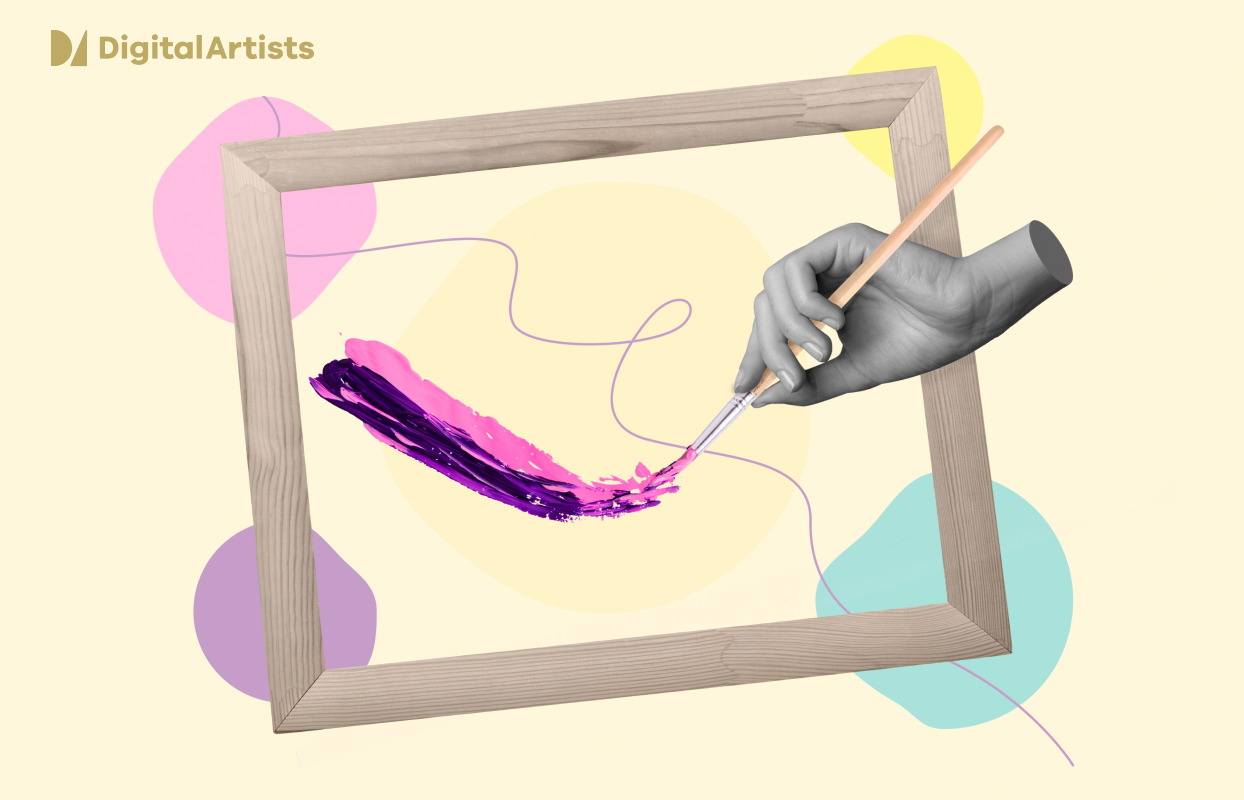


11 MIN. READ
Collage art has been around for centuries, starting with the first paper collage art in the early 1900s. It’s always had a certain charm to it and somehow manages to draw out our imagination – challenging us to come up with creative ways of combining seemingly unrelated objects or images into dynamic and unexpected works of art.
Over time, this form of visual expression has evolved from simple hand-cut and pasted pieces, onto more sophisticated digital forms using software tools such as Photoshop or GIMP. Today’s collage artists are pushing the boundaries even further by integrating technology, video capture, animation and 3D imaging into their concepts; bringing forth unprecedented opportunities which promise to change not only how we perceive art but also create new ways of expressing creativity through cutting-edge artistic experiments. This post will explore how far collage arts have come, its present applications in today’s digital world and forecast the future potential this medium holds for modern day art creation.
Collage art is a form of artwork that is created by assembling smaller parts to create something entirely new. Collages can be made from any material including paper, fabrics, photographs, objects and colors. Collages often have different meanings when observed from different perspectives and can evoke strong emotions in its viewers. Collage art first gained notoriety in the early 20th century within the surrealist movement, but has since surged in popularity again due to advances in technology that allow for easier access and manipulation of images. Collages are unique pieces of art that make use of existing elements to create striking visuals; they captivate an audience with their multilayered complexity and unexpected juxtapositions.
Collage art has been around for literally hundreds of years, but it is only recently that artists have begun to categorize and recognize different types of collages. There are 4 main types of collages: papier collé, découpage, photomontage, and assemblage.
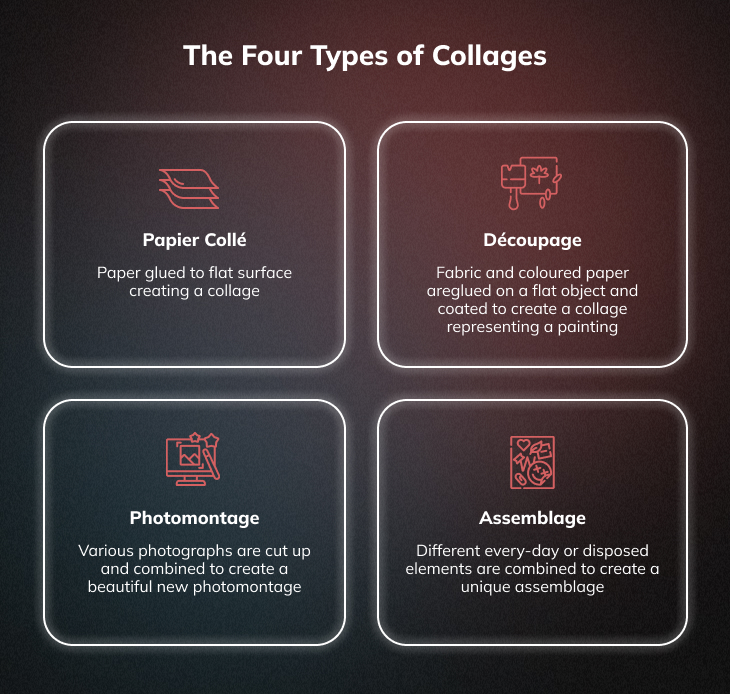

Each type of collaging technique has its own unique properties, techniques and effects it can create. Papier collé, a captivating French technique that bridges the divide between drawing and painting. Through this method of pasted paper manipulation, an artist can create unique compositions with layers of mesmerizing textures. Decoupage involves layering multiple images onto a basplate and adds additional visual elements such as cutting, piecing and/or gluing items together. Photomontage uses photographs as part of the composition process, usually being overlayed with other visual items. Lastly, assemblage involves taking preassembled objects or objects found in nature and creating a composition from them.
Papier collé is an artistic medium of collage which consists of materials such as paper, newspaper and other ephemera that are glued to a backing surface creating an image or pattern. It was developed by the likes of Pablo Picasso, Georges Braque, Joan Miro and Marcel Duchamp in the early 20th century. As a unique art style, papier collé offers a creative play with colors, textures, shapes and sizes.
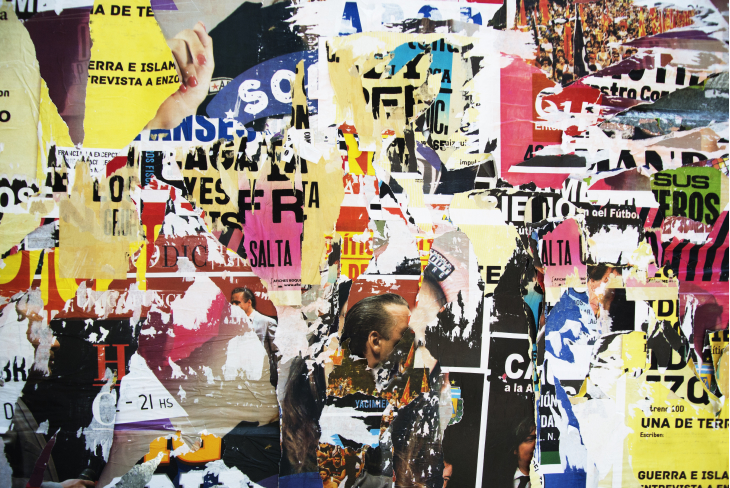
The technique provides artists with the ability to experiment with layered techniques while rearranging pieces of paper and graphite drawings on a blank canvas or ground. By fusing various elements to display visual forms of motion and physical materiality, papier collé can express distinctive personal narratives through its narratives of social commentary. Its versatility in engaging with materials that have greater history makes it particularly interesting for viewers to appreciate!
Découpage is an art form involving the use of paper and other items to decorate surfaces. It dates back to the 18th century, but has acquired a greater prominence in recent years as a creative form of art. As its name implies, découpage involves cutting or tearing paper into elements at different shapes and sizes and then applying them to the desired surface with glue or some other adhesive, creating detailed layers that look like a collage.
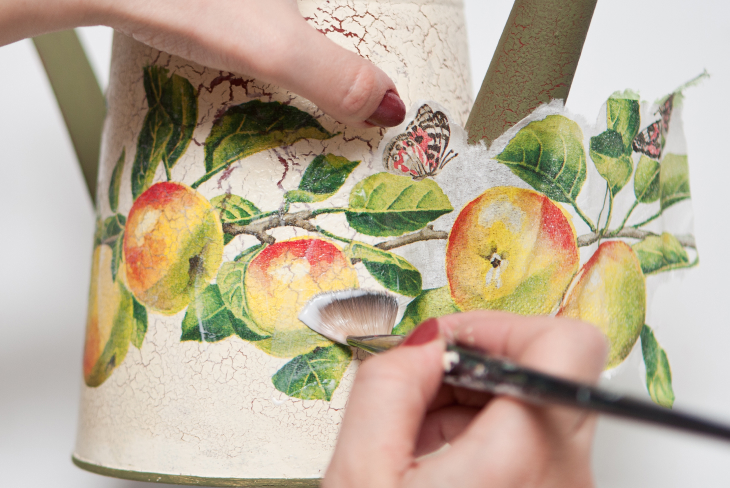
Generally speaking, the artwork can be done on any flat surface such as wood, metal, walls, glass or canvas and a variety of objects such as boxes, furniture and even simple toys. Despite being most common in decorative home objects such as boxes, trays and chests from older times, modern découpage artists also work with more complex media pieces like sculptures and large murals that take a small space but make a bold statement. Découpage is an incredibly enjoyable practice for an artist looking for meaningful art that doubles up as a relaxing craft activity – definitely worth trying out!
Photomontage is a type of collage artwork that combines two or more photographs onto a single surface. Photomontage allows for the creation of dynamic pieces of art and depends heavily on the juxtaposition of multiple images. Despite working within the same medium, photomontage artists often employ vastly different methods to create their work.
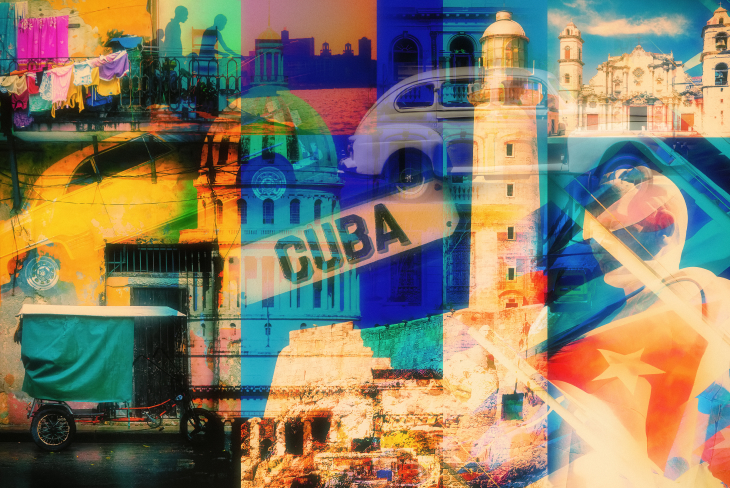
Some may use cut-and-paste techniques to piece together juxtapositions of photographs while others may overlap them digitally in Photoshop or other graphics software. Whatever they choose, photomontage artists are typically dedicated to exploring themes such as chaos and order, time, dreams, memory and identity – just as any other artist might explore these issues through paint or sculpture.
Assemblage, the type of collage which was developed in the early 1950s, is now widely accepted as an important branch of modern art. It involves the combination of found or discarded materials to create sculptural forms or moving parts as if they were picked up from a real-life environment and repurposed into something new and original. The term “assemblage” derives from French and means to assemble or group together, referring to the assembling of different types of objects into one sculpture.
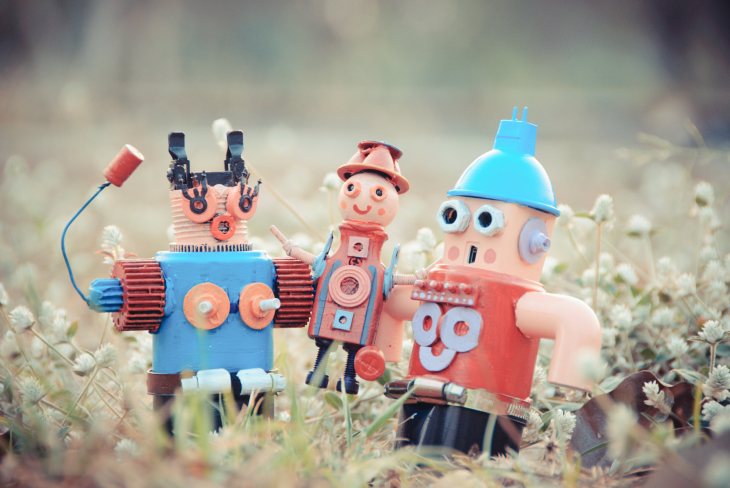
Assemblage artists use everyday objects such as furniture, musical instruments, kitchen utensils, fabric or any other material to transform them into visually stunning works of art that have deeper meanings beyond just decoration. It allows viewers to discover a whole new breadth of creativity through pieces that represent different influences and backgrounds with stories that can often challenge viewers with thought-provoking themes.
Collage art has been around since the early twentieth century, but over time it has evolved significantly. Collage artwork is the process of combining diverse materials such as photographs, illustrations, fabrics and other materials and incorporating them into a single composition. Initially, collaging techniques required cutting physical paper and mounting them with glue to create images. However, technology has become an important part of this artistic medium. Digital resources now provide collagers with a much wider array of possibilities for their designs, from layering digital photos together to creating layered patterns using digital elements like fonts or shapes. Collagers have also broadened their scope by using everyday objects in their work instead of relying solely on traditional media such as magazines and books. Collage art provides an interesting way to express creativity and explore various visual textures within one piece. Overall, technology advancements have had a major impact on the evolution of collaging techniques and will continue to shape this ever-changing art form in fascinating ways.
The first collage art was created in 1912 by artist, Pablo Picasso. The work, entitled Guitar, Sheet Music and Glass, was the progenitor of the modern art of collage. The idea for it was generated after the reconstruction of paper scraps to become three-dimensional objects prompted Picasso to apply components of his own works into a new piece.
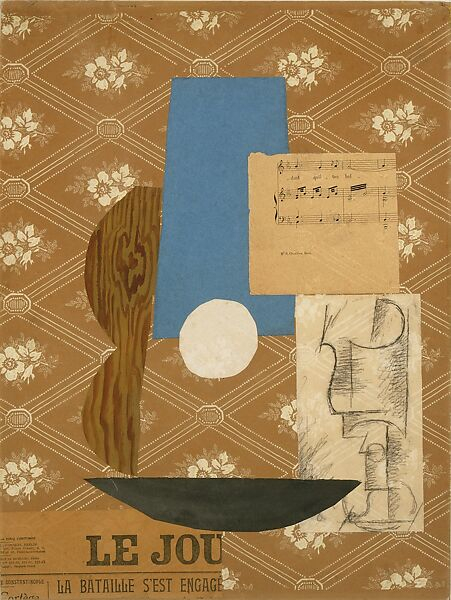
It incorporated newspaper clippings combined with painted elements to create a multi-faceted piece that was truly ahead of its time. This revolutionary concept quickly gained traction with other iconic artists such as George Braque, who built upon this nascent form of art in order to develop an entirely new aesthetic that still stands today.
Collage art is a unique and recognizable form of expression that has been around for many years. The mixture of existing imagery, symbols, and various materials creates beautiful layers for people to explore and interpret. Over time, these collages have become more experimental, with the advent of digital tools allowing artisits to create intricate pieces from digital materials. This modern take on traditional collage art pieces has now made its way into the burgeoning world of NFT collage artwork.
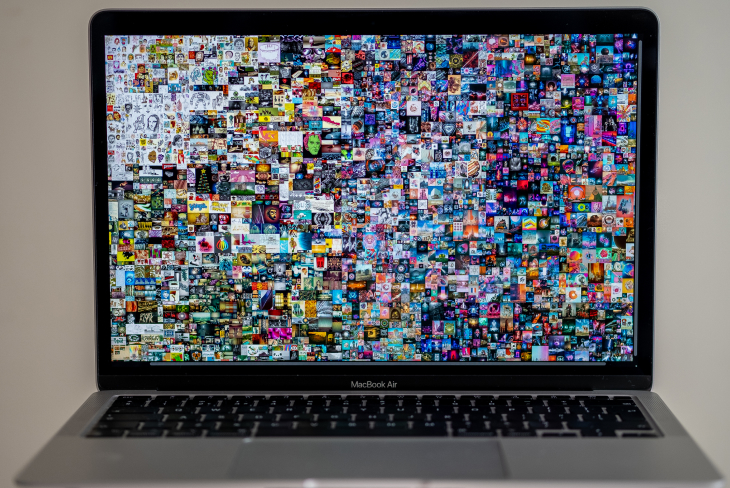
With NFTs (non-fungible tokens), tangibile virtual objects are created that can be bought, sold and exchanged much like a physical work of art but without the limits imposed by physicality or location. Modern NFT collage compositions offer considerable flexibility where artists can collect items from external sources or even personal photographs or images, before transforming them into one cohesive composition – further entrenching us in an age where our homes are as much galleries as anything else.
Collage is like a hall of mirrors, every direction you look, you see something different and visually stimulating.
– Nita Leland
Everyone can certainly appreciate the visual collage art form that has graced our signs and perspective with vitality, emotion and originality. As collaging techniques grow and become more integrated within artwork, we can expect to see this creative expression continue to evolve over the coming years. Modern collages create something altogether more complex and sophisticated incorporating techniques that were not available even just a few years ago. Professional collagers are also becoming aware of how they give meaning to their pieces by taking previously unrelated elements and bringing them together in a new very special way. It is safe to say that collage art holds an exciting place in the contemporary world which will only continue to get brighter as time passes.
Types of collages have consistently left a lasting influence on modern visuals, and this significant impact will be seen for generations to come. To better understand its relevance in today’s world we’ve answered some of the most frequently asked questions below.
When considering whether collage constitutes an artistic style, the answer is a resounding ‘Yes.’ Compared to other art forms, collages require a unique combination of creative elements, technical skill, and composition.
Collaging is an art form that offers a wide variety of creative possibilities. Papier collé, découpage, photomontage and assemblage are the four main types of collages used to create this unique style; each imbues its own special properties which can be combined for even greater effects!
The artistic technique, known as collage, is credited to Pablo Picasso and Georges Braque, who originated the concept of combining everyday objects and newspaper clippings into their artwork.
Collage art encourages creative expression in a unique way by allowing artists to utilize their original ideas while making something new out of the existing elements. This allows them to make a truly personal connection with the artwork that they are creating, as well as providing an outlet for ideas and thoughts that might otherwise remain unexpressed.
To make an effective collage, there are several steps:
Collage art is a popular form of expression, and there’s no better way to monetize it than by selling it as an NFT. With the booming success of NFTs in the art world, savvy collagists can now take advantage of this trend by tokenizing their works and earning royalties from trades or sales.